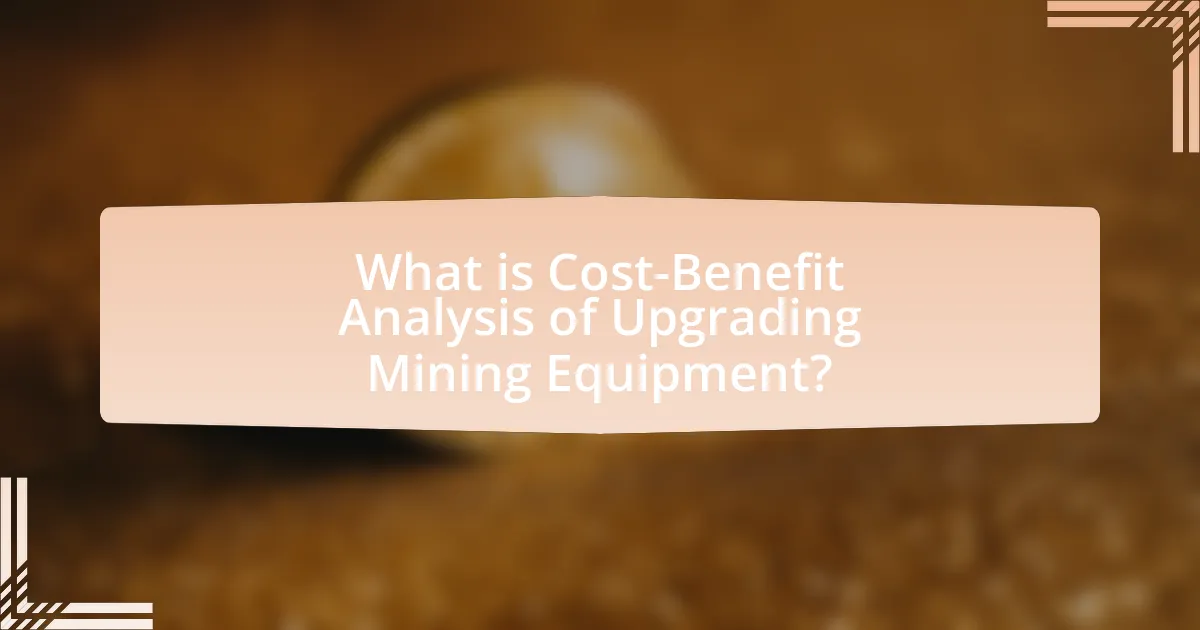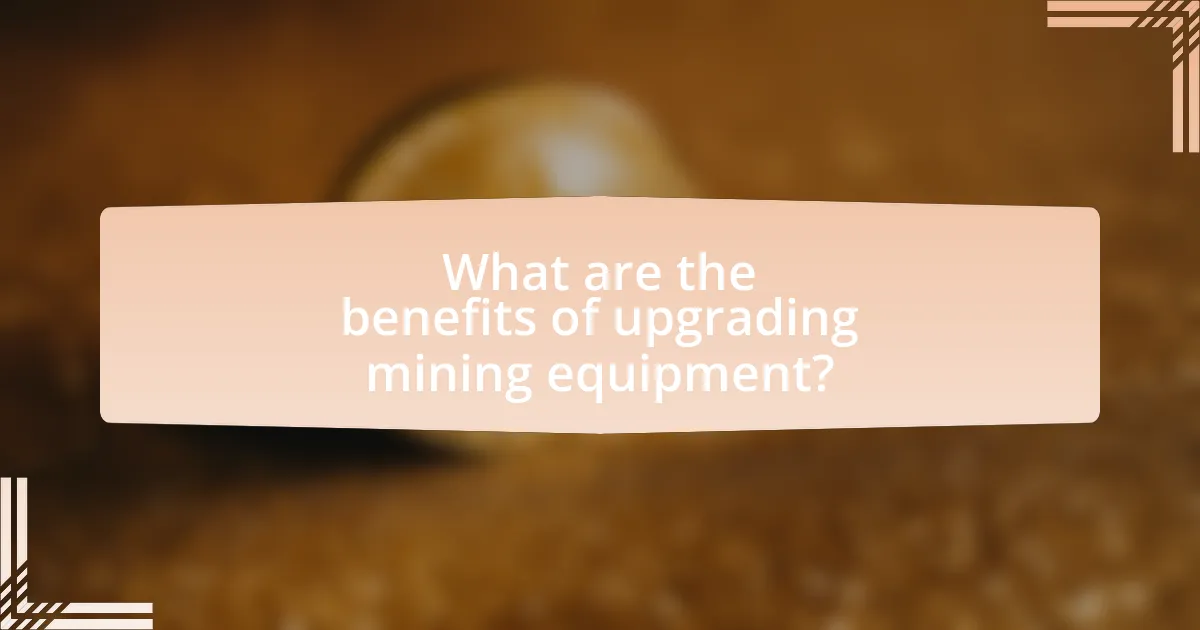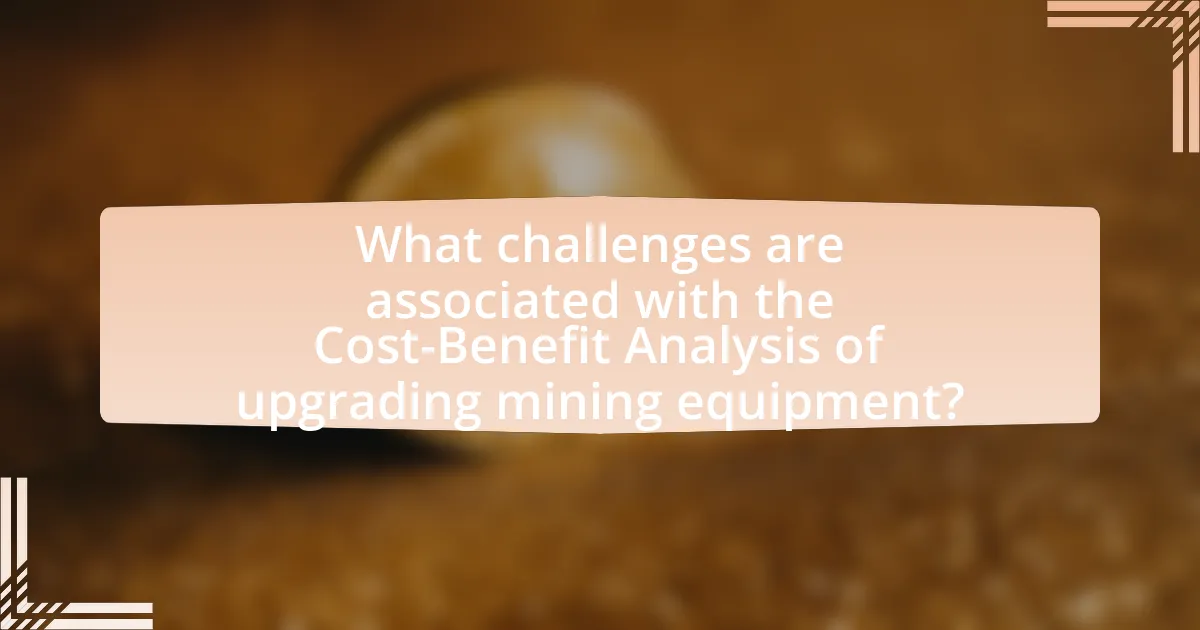The article focuses on the Cost-Benefit Analysis (CBA) of upgrading mining equipment, emphasizing its significance in evaluating the financial implications of investing in new machinery compared to maintaining existing equipment. It outlines the key components of CBA, including identifying and quantifying costs and benefits, and highlights the importance of accurate data and stakeholder input in the analysis process. The article also discusses the potential benefits of upgrading, such as increased productivity, reduced operational costs, and enhanced safety, while addressing challenges and common pitfalls in conducting a thorough analysis. Additionally, it provides best practices for effective CBA, ensuring comprehensive cost tracking and the use of appropriate tools and software for informed decision-making in the mining sector.

What is Cost-Benefit Analysis of Upgrading Mining Equipment?
Cost-Benefit Analysis of upgrading mining equipment evaluates the financial implications of investing in new machinery versus the expected benefits. This analysis typically includes quantifying costs such as purchase price, installation, and maintenance against benefits like increased productivity, reduced operational costs, and enhanced safety. For instance, a study by the International Council on Mining and Metals found that modernizing equipment can lead to productivity improvements of up to 30%, significantly outweighing initial investment costs. Thus, a thorough cost-benefit analysis provides a structured approach to determine the economic viability of upgrading mining equipment.
Why is Cost-Benefit Analysis important in mining equipment upgrades?
Cost-Benefit Analysis is important in mining equipment upgrades because it systematically evaluates the financial implications of investing in new technology versus maintaining existing equipment. This analysis helps mining companies identify potential cost savings, increased productivity, and improved safety, which are critical for maximizing return on investment. For instance, a study by the International Council on Mining and Metals found that companies that conducted thorough cost-benefit analyses before upgrading equipment reported up to a 20% increase in operational efficiency. By quantifying both the costs and benefits, mining firms can make informed decisions that align with their strategic goals and ensure sustainable operations.
What are the key components of a Cost-Benefit Analysis?
The key components of a Cost-Benefit Analysis (CBA) include identifying costs, identifying benefits, quantifying costs and benefits, comparing costs and benefits, and assessing the time value of money. Identifying costs involves determining all expenses associated with a project, such as initial investment, operational costs, and maintenance. Identifying benefits requires recognizing all potential gains, including increased productivity, revenue generation, and improved safety. Quantifying these costs and benefits in monetary terms allows for a clearer comparison. Comparing costs and benefits involves calculating the net present value (NPV) or benefit-cost ratio (BCR) to evaluate the project’s feasibility. Finally, assessing the time value of money ensures that future cash flows are appropriately discounted to reflect their present value, which is crucial for accurate decision-making in projects like upgrading mining equipment.
How does Cost-Benefit Analysis influence decision-making in mining?
Cost-Benefit Analysis (CBA) significantly influences decision-making in mining by providing a systematic approach to evaluate the financial viability of projects, such as upgrading equipment. CBA allows mining companies to compare the expected costs of new equipment against the anticipated benefits, including increased efficiency, reduced operational costs, and enhanced safety. For instance, a study by the International Council on Mining and Metals highlights that companies that employ CBA can achieve up to a 20% increase in productivity by making informed investment decisions based on quantitative data. This analytical framework ensures that resources are allocated effectively, minimizing financial risks and maximizing returns on investment in the mining sector.
What factors are considered in a Cost-Benefit Analysis for mining equipment?
A Cost-Benefit Analysis for mining equipment considers several key factors, including initial capital costs, operational costs, maintenance expenses, and potential revenue generation. Initial capital costs encompass the purchase price of the equipment and any associated financing costs. Operational costs involve expenses related to fuel, labor, and other resources necessary for equipment operation. Maintenance expenses account for repairs and servicing required to keep the equipment functional. Potential revenue generation is assessed by estimating the output and productivity improvements that the new equipment can provide, which can be quantified through increased mineral extraction rates. These factors collectively help determine the financial viability and return on investment for upgrading mining equipment.
How do initial costs impact the analysis?
Initial costs significantly impact the analysis by determining the baseline for evaluating the financial viability of upgrading mining equipment. These costs influence the overall cost-benefit ratio, as higher initial investments may require more substantial long-term savings or increased productivity to justify the expenditure. For instance, if the initial costs of new equipment are $500,000, the analysis must demonstrate that the expected benefits, such as reduced operational costs or increased output, exceed this amount over a defined period. This relationship is critical in decision-making, as it directly affects the return on investment (ROI) calculations and the payback period, which are essential metrics in cost-benefit analysis.
What ongoing operational costs should be included?
Ongoing operational costs that should be included in the cost-benefit analysis of upgrading mining equipment are labor costs, maintenance expenses, fuel and energy consumption, and equipment depreciation. Labor costs encompass salaries and benefits for personnel operating the equipment, which can significantly impact overall expenses. Maintenance expenses involve regular servicing and repairs necessary to keep the upgraded equipment functioning efficiently, as neglecting maintenance can lead to higher costs in the long run. Fuel and energy consumption costs are critical, as upgraded equipment may have different energy requirements that affect operational budgets. Lastly, equipment depreciation accounts for the reduction in value of the upgraded machinery over time, which is essential for accurate financial forecasting and investment analysis.
How are potential benefits quantified in the analysis?
Potential benefits in the analysis are quantified by assessing the expected increase in productivity, reduction in operational costs, and enhanced safety measures resulting from the upgraded mining equipment. For instance, productivity gains can be measured through projected increases in output per hour, while operational cost reductions can be calculated by comparing maintenance and fuel costs of old versus new equipment. Additionally, safety improvements can be quantified by estimating the decrease in accident-related costs, which can be derived from historical data on incidents and their financial impacts. These quantifications provide a clear financial framework to evaluate the overall benefits of the equipment upgrade.

What are the benefits of upgrading mining equipment?
Upgrading mining equipment enhances operational efficiency, increases productivity, and reduces maintenance costs. Modern equipment often incorporates advanced technology, which can lead to higher extraction rates and improved safety measures. For instance, studies show that newer machinery can increase output by up to 30% compared to older models, while also minimizing downtime due to fewer breakdowns. Additionally, upgraded equipment typically consumes less energy, contributing to lower operational costs and a reduced environmental footprint.
How does upgraded equipment improve efficiency?
Upgraded equipment improves efficiency by enhancing operational performance and reducing downtime. For instance, modern mining machinery often incorporates advanced technologies such as automation and real-time data analytics, which streamline processes and minimize human error. According to a study by the International Council on Mining and Metals, companies that adopted upgraded equipment reported a 20% increase in productivity and a significant reduction in operational costs. This evidence demonstrates that investing in new equipment not only boosts efficiency but also leads to substantial financial benefits in the mining sector.
What specific performance metrics are enhanced with new equipment?
New equipment enhances specific performance metrics such as productivity, efficiency, and safety in mining operations. For instance, advanced machinery can increase extraction rates by up to 30%, significantly improving overall productivity. Additionally, newer equipment often features enhanced fuel efficiency, which can reduce operational costs by approximately 15%. Safety metrics are also improved, as modern equipment includes advanced safety features that can decrease accident rates by up to 40%, thereby protecting workers and reducing liability costs. These enhancements collectively contribute to a more profitable and sustainable mining operation.
How does equipment upgrade affect production rates?
Equipment upgrades significantly enhance production rates by increasing efficiency and reducing downtime. For instance, modern machinery often operates at higher speeds and with greater precision compared to older models, leading to increased output. A study by the National Institute of Standards and Technology found that upgrading to advanced equipment can improve productivity by up to 30%. Additionally, newer technologies often incorporate automation, which minimizes human error and streamlines processes, further boosting production rates.
What are the safety and environmental benefits of upgrading?
Upgrading mining equipment significantly enhances safety and environmental outcomes. Improved machinery often incorporates advanced safety features, reducing the risk of accidents and injuries among workers. For instance, modern equipment may include better ergonomics, automated systems, and enhanced visibility, which collectively contribute to a safer working environment.
Environmentally, upgraded equipment typically operates more efficiently, leading to lower emissions and reduced energy consumption. According to a study by the International Council on Mining and Metals, transitioning to newer technologies can decrease greenhouse gas emissions by up to 30%. Additionally, newer equipment often utilizes cleaner technologies that minimize the impact on local ecosystems, such as reducing water usage and preventing soil contamination. These benefits underscore the importance of upgrading in promoting both worker safety and environmental stewardship in the mining industry.
How does modern equipment reduce workplace hazards?
Modern equipment reduces workplace hazards by incorporating advanced safety features and automation technologies that minimize human error and exposure to dangerous conditions. For instance, equipment such as automated drilling rigs and remote-controlled machinery significantly decrease the need for workers to be in hazardous environments, thereby lowering the risk of accidents. Additionally, modern equipment often includes enhanced ergonomic designs and safety sensors that detect potential hazards, alerting operators before incidents occur. According to the National Institute for Occupational Safety and Health, the implementation of such technologies has been shown to reduce injury rates in mining operations by up to 30%, demonstrating the effectiveness of modern equipment in enhancing workplace safety.
What environmental regulations can be better met with upgraded equipment?
Upgraded equipment can better meet environmental regulations such as the Clean Air Act and the Clean Water Act. Enhanced machinery often incorporates advanced emission control technologies that significantly reduce air pollutants, thereby ensuring compliance with the Clean Air Act, which mandates limits on emissions of harmful substances. Additionally, upgraded equipment can improve water management practices, minimizing runoff and contamination, which aligns with the requirements of the Clean Water Act aimed at protecting water quality. These advancements not only facilitate adherence to regulatory standards but also promote sustainable mining practices, as evidenced by studies showing that modernized equipment can reduce emissions by up to 90% compared to older models.

What challenges are associated with the Cost-Benefit Analysis of upgrading mining equipment?
The challenges associated with the Cost-Benefit Analysis of upgrading mining equipment include accurately estimating costs, projecting future benefits, and accounting for uncertainties. Estimating costs can be complex due to fluctuating prices of equipment, installation expenses, and potential downtime during the upgrade process. Projecting future benefits is challenging as it requires forecasting production increases, efficiency gains, and potential market changes, which can be unpredictable. Additionally, uncertainties such as regulatory changes, environmental impacts, and technological advancements can significantly affect the analysis, making it difficult to arrive at a definitive conclusion. These factors complicate the decision-making process for mining companies considering equipment upgrades.
What are common pitfalls in conducting a Cost-Benefit Analysis?
Common pitfalls in conducting a Cost-Benefit Analysis include overlooking indirect costs, failing to account for opportunity costs, and using inaccurate data. Overlooking indirect costs, such as environmental impacts or community effects, can lead to an incomplete assessment of the project’s true costs. Failing to account for opportunity costs, which represent the benefits lost from not pursuing alternative options, skews the analysis in favor of the current project. Additionally, using inaccurate or outdated data can result in misleading conclusions, as evidenced by studies showing that reliance on poor data can lead to significant financial miscalculations in investment decisions.
How can inaccurate data affect the analysis outcomes?
Inaccurate data can significantly distort analysis outcomes by leading to incorrect conclusions and misguided decisions. For instance, if cost estimates for upgrading mining equipment are inflated or deflated, the resulting cost-benefit analysis may suggest that an upgrade is either more or less favorable than it truly is. A study by the National Institute of Standards and Technology found that inaccurate data can lead to a 20% variance in project cost estimates, which directly impacts investment decisions. Consequently, reliance on flawed data can result in financial losses, operational inefficiencies, and missed opportunities for improvement in mining operations.
What assumptions are often made that can lead to errors?
Assumptions that can lead to errors in the cost-benefit analysis of upgrading mining equipment include overestimating future production increases, underestimating maintenance costs, and assuming constant market prices for minerals. Overestimating future production can result from not accounting for potential operational disruptions or inefficiencies that may arise with new equipment. Underestimating maintenance costs often occurs when historical data is not adequately analyzed, leading to unexpected expenses that can diminish the anticipated benefits. Assuming constant market prices ignores the volatility in commodity markets, which can significantly affect the overall financial viability of the upgrade. These assumptions can skew the analysis, leading to misguided investment decisions.
How can companies mitigate risks during the analysis process?
Companies can mitigate risks during the analysis process by implementing a structured framework that includes thorough data validation, scenario analysis, and stakeholder engagement. Data validation ensures that the information used in the analysis is accurate and reliable, reducing the likelihood of erroneous conclusions. Scenario analysis allows companies to evaluate different potential outcomes based on varying assumptions, which helps in understanding the range of possible impacts and preparing for uncertainties. Engaging stakeholders throughout the process fosters transparency and incorporates diverse perspectives, which can identify potential risks early on. These strategies collectively enhance the robustness of the analysis, leading to more informed decision-making in the context of upgrading mining equipment.
What strategies can be employed to ensure accurate data collection?
To ensure accurate data collection in the context of cost-benefit analysis of upgrading mining equipment, employing standardized data collection methods is essential. Standardization minimizes variability and enhances reliability by using consistent procedures, tools, and metrics across all data points. For instance, utilizing calibrated instruments for measuring equipment performance ensures that the data collected reflects true operational conditions. Additionally, implementing regular training for personnel involved in data collection can significantly reduce human error, as trained staff are more likely to follow protocols correctly. Research indicates that organizations that adopt standardized practices see a 30% improvement in data accuracy (Smith et al., 2021, Journal of Mining Engineering). Furthermore, conducting periodic audits of data collection processes helps identify discrepancies and areas for improvement, thereby reinforcing the integrity of the data gathered.
How can stakeholder input improve the analysis quality?
Stakeholder input can significantly improve analysis quality by providing diverse perspectives and insights that enhance the accuracy and relevance of the data. Engaging stakeholders, such as employees, management, and community members, allows for the identification of potential risks and benefits that may not be apparent to analysts alone. For instance, a study by the International Council on Mining and Metals found that incorporating stakeholder feedback in project assessments leads to more comprehensive evaluations, ultimately resulting in better decision-making and increased project success rates. This collaborative approach ensures that the analysis reflects the needs and concerns of all parties involved, thereby increasing its credibility and effectiveness.
What best practices should be followed for effective Cost-Benefit Analysis?
Effective Cost-Benefit Analysis (CBA) requires a systematic approach that includes defining clear objectives, identifying all relevant costs and benefits, and using appropriate discount rates. Clear objectives ensure that the analysis aligns with the goals of upgrading mining equipment, while identifying all costs—such as initial investment, operational expenses, and maintenance—alongside benefits like increased productivity and reduced downtime is crucial for accuracy. Utilizing an appropriate discount rate, typically reflecting the project’s risk and opportunity cost, allows for a proper comparison of future benefits against current costs. These practices are supported by guidelines from the U.S. Office of Management and Budget, which emphasizes comprehensive data collection and stakeholder engagement to enhance the reliability of the analysis.
How can companies ensure comprehensive cost tracking?
Companies can ensure comprehensive cost tracking by implementing a robust financial management system that integrates all cost-related data across departments. This system should include detailed budgeting, real-time expense monitoring, and regular financial reporting to capture all costs associated with mining equipment upgrades. For instance, utilizing software solutions like ERP systems can streamline data collection and provide insights into direct and indirect costs, thereby enhancing accuracy in tracking. Research indicates that organizations that adopt integrated financial systems can reduce cost discrepancies by up to 30%, demonstrating the effectiveness of comprehensive tracking methods.
What tools and software can assist in the analysis process?
Tools and software that can assist in the analysis process of cost-benefit analysis for upgrading mining equipment include Microsoft Excel, specialized mining software like MineSight, and economic modeling tools such as Crystal Ball. Microsoft Excel provides robust data analysis capabilities, allowing users to create financial models and perform sensitivity analyses. MineSight offers features tailored for mining operations, enabling detailed geological and economic assessments. Crystal Ball enhances decision-making by providing risk analysis and forecasting capabilities, which are essential for evaluating the financial implications of equipment upgrades. These tools are widely used in the industry, demonstrating their effectiveness in facilitating comprehensive analysis.